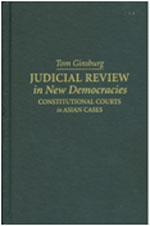
| Judul | Judicial Review in New Democracies : Constitutional Courts in Asian Cases / Ginsburg Thomas |
| Pengarang | Ginsburg, Thomas |
| Penerbitan | Cambridge : Cambridge University Press, 2003 |
| Deskripsi Fisik | xi, 295p. :: illus. ;23 cm. |
| ISBN | 0521817153 |
| Subjek | Judicial review - East Asia Constitutional courts - East Asia |
| Abstrak | In recent decades, new democracies around the world have adopted constitutional courts to oversee the operation of democratic politics. Where does judicial power come from, how does it develop in the early stages of democratic liberalization, and what political conditions support its expansion?. This book answers these questions through an examination of three constitutional courts in Asia: Taiwan, Korea, and Mongolia. In a region where law has traditionally been viewed as a tool of authoritarian rulers, constitutional courts in these three societies are becoming a real constraint on government. In contrast with conventional culturalist accounts, this book argues that the design and function of constitutional review are largely a function of politics and interests. Judicial review - the power of judges to rule an act of a legislature or executive unconstitutional - is a solution to the problem of uncertainty in constitutional design. By providing insurance to prospective electoral losers, judicial review can facilitate democracy. Chapter 3 discusses the structure of federal courts, their role, and the power of judicial review. The fourth chapter covers the jurisdiction of federal courts. Included discussions of how these principles apply to real cases with which the student may have contact. The powers of Congress are the topic of Chapter 5 and presidential powers are discussed in Chapter 6. Election, impeachment, and duties are all discussed in these chapters. Chapter 7 examines the creation of agencies, delegation of powers to agencies, and presidential and congressional control of agencies, as well as other contemporary topics. Finally, Chapter 8 covers contemporary federalism. The period bracketed by the dramatic moments of 1937 and 1954, written off as a forgotten time of failure and futility, was in reality the first phase of modern struggles to define the constitutional order that will dominate the twenty - first century. |
| Catatan | Indeks : p.281-295 p.265-280 |
| Bahasa | Inggris |
| Bentuk Karya | Bukan fiksi atau tidak didefinisikan |
| Target Pembaca | Tidak ada kode yang sesuai |
| No Barcode | No. Panggil | Akses | Lokasi | Ketersediaan |
|---|---|---|---|---|
| 00000011583 | 347.5035 GIN j | Dapat dipinjam | Perpustakaan Lantai 3 - Mahkamah Konstitusi RI | Tersedia
pesan |
| Tag | Ind1 | Ind2 | Isi |
| 001 | INLIS000000000003054 | ||
| 005 | 20241018100833 | ||
| 008 | 241018################|##########0#eng## | ||
| 020 | # | # | $a 0521817153 |
| 035 | # | # | $a 0010-0520003054 |
| 041 | $a eng | ||
| 082 | # | # | $a 347.5035 |
| 084 | # | # | $a 347.5035 GIN j |
| 100 | 0 | # | $a Ginsburg, Thomas |
| 245 | 1 | # | $a Judicial Review in New Democracies : Constitutional Courts in Asian Cases /$c Ginsburg Thomas |
| 260 | # | # | $a Cambridge :$b Cambridge University Press,$c 2003 |
| 300 | # | # | $a xi, 295p. : $b : illus. ; $c 23 cm. |
| 500 | # | # | $a Indeks : p.281-295 |
| 504 | # | # | $a p.265-280 |
| 520 | # | # | $a In recent decades, new democracies around the world have adopted constitutional courts to oversee the operation of democratic politics. Where does judicial power come from, how does it develop in the early stages of democratic liberalization, and what political conditions support its expansion?. This book answers these questions through an examination of three constitutional courts in Asia: Taiwan, Korea, and Mongolia. In a region where law has traditionally been viewed as a tool of authoritarian rulers, constitutional courts in these three societies are becoming a real constraint on government. In contrast with conventional culturalist accounts, this book argues that the design and function of constitutional review are largely a function of politics and interests. Judicial review - the power of judges to rule an act of a legislature or executive unconstitutional - is a solution to the problem of uncertainty in constitutional design. By providing insurance to prospective electoral losers, judicial review can facilitate democracy. Chapter 3 discusses the structure of federal courts, their role, and the power of judicial review. The fourth chapter covers the jurisdiction of federal courts. Included discussions of how these principles apply to real cases with which the student may have contact. The powers of Congress are the topic of Chapter 5 and presidential powers are discussed in Chapter 6. Election, impeachment, and duties are all discussed in these chapters. Chapter 7 examines the creation of agencies, delegation of powers to agencies, and presidential and congressional control of agencies, as well as other contemporary topics. Finally, Chapter 8 covers contemporary federalism. The period bracketed by the dramatic moments of 1937 and 1954, written off as a forgotten time of failure and futility, was in reality the first phase of modern struggles to define the constitutional order that will dominate the twenty - first century. |
| 650 | 4 | $a Constitutional courts - East Asia | |
| 650 | 4 | $a Judicial review - East Asia | |
| 990 | # | # | $a 11583/MKRI-P/XII-2008 |
Content Unduh katalog
Karya Terkait :